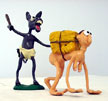| J u n e 2 4 - A u g u s t 2 6 , 2 0 0 0 | ||
|
|
|
|
 Power Tools Catalogues Rubén Ortiz Torres' bold new paintings--large, monochromatic works made with car paint and steel--bring together three distinct and seemingly irreconcilable aspects of his creative background: his early classical education at the National School of Fine Arts in Mexico, his graduate education at the theory-heavy California Institute of the Arts, and his subsequent collaborations with car painters and customizers in Mexico and southern California. "I am taking this opportunity to come out of the closet," he writes, "with a series of paintings that negotiate the contradictions between formal and conceptual puritanism and the beautiful, seductive quality of materials people in the barrio use to turn cars into an expressive medium--whether that be painting, art or transportation." Also on display are Ortiz's customized leaf blowers, made in collaboration with Godi Sanchez. One of these two leafblowers was adapted to run on an electric motor by Sanchez, a religious car mechanic who maintains that God showed him the way to make a machine that would help ease the heavy labor of gardeners without creating noise and pollution; the other was customized by Ortiz with a candy apple paintjob, a 24 karat gold plated engine, and velvet upholstery. These functional sculptures--one fitted for style, one for efficiency--play on recent controversial legislation against the use of leafblowers in the city of Los Angeles as well as exploring the interplay between form and function that characterizes the customizer's relationship to his machine. |
 On the Pan-American Highway Catalogues The paintings of Cuban artist Pedro Alvarez are dense tapestries that weave art historical and pop culture images together to explore issues of geography, race, and identity, challenging viewers to look beneath the surface of their own cultural foundations. In some works, Alvarez papers his canvases with pages from expensive art catalogues and covers them with painted scenes from cigar box labels; in others he inserts figures from 19th-century Latin American paintings into backdrops from Disney cartoons and old Florida postcards. In these juxtapositions of high and low culture, Alvarez alludes to the means by which the Cuban artist is admitted into the contemporary art world: an allegiance to the Western canon validates the work while a taste of the exotic makes it desirable. Alvarez does not separate himself from these cultural snares, but rather uses them to illuminate--in stunning color--the deeper mechanics of identity and power that operate within them. A discussion with the all three of the artists, moderated by Kevin Power, will be held at the gallery on June 30, 2000, at 7:30 p.m. Kevin Power, who curated Track 16's 1999 exhibition While Cuba Waits, is a curator and writer who teaches in Cuba and Spain. |
 Soon After Before In a similar act of cultural collage, Mexican artist Eduardo Abaroa uses everyday objects like cotton swabs, plastic bags, bread, mirrors, and costume jewelry to make playful and at times grotesque sculptures that function like riddles waiting to be deciphered. Many of the sculptures--like one series of brightly colored figurines titled Anatomical Impertinence--appear benign, even cute, at first glance, only to reveal a more perverse nature: a cheerful horse, an elephant, and a camel ride on naked caricatures of the men who should be their masters; a three-eyed chicken roasts a naked man on a spit; a blue fish hooks another man on the end of a fishing rod. In another piece, families of Sea Monkeys from Atlantis are depicted making a porn film, teaching yoga, and picketing for the annihilation of whales. Abaroa's work hinges on a sense of the extraordinary--on that brief glimpse of monstrous wonder that exists within aberration. As Cuauhtémoc Medina writes in the exhibition catalogue: "In a serialized world, the monstrous may be art's last refuge. It is precisely in what has been degraded and distorted, in what is made unique by its defects, that we are able to preserve the power of seduction and individuality. This is the singularity that, perversely, Abaroa's riddles strive to preserve." Smart Art Press Catalogue |